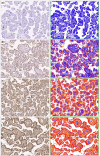Innovative approach for the qualitative-quantitative assessment of neurodevelopment biomarkers research in placenta tissue using immunohistochemistry digital image analysis
- PMID: 40809868
- PMCID: PMC12349919
- DOI: 10.1093/biomethods/bpaf056
Innovative approach for the qualitative-quantitative assessment of neurodevelopment biomarkers research in placenta tissue using immunohistochemistry digital image analysis
Abstract
We aimed to develop and validate a standardized, qualitative-quantitative protocol for digital IHC analysis to assess neurodevelopmental biomarkers in placental tissue. Placental tissues from 60 births were obtained from the Western Region Birth Cohort (ROC), and IHC staining was performed using NovolinkTM Polymer System. The primary antibody against 11βHSD2 protein was used for protocol development, and ANXA1 was employed for validation. Slides were digitized using the Aperio ScanScope XT, and image analysis was conducted using the Positive Pixel Count V9 algorithm. Protein expression levels were calculated using the IHC Index formula. Protocol steps included combined optical and digital evaluation, representative fields per slide, intra- and interobserver validation, and assessment of reproducibility. Digital analysis of three random fields (scale bar: 300 µm) showed strong concordance with optical microscopy assessments for 11βHSD2 placental expression. Intraobserver validation showed a strong correlation (τ: 0.70, P < .001) and a substantial concordance (kw: 0.67; P-value < .001), while interobserver comparisons also yielded substantial agreement (kw: 0.61, P < .001), confirming the protocol's reliability. Validation using ANXA1 expression revealed moderate intra- and interobserver concordance (kw: 0.50 and kw: 0.48, respectively; both P < .001), reinforcing the protocol's applicability across different proteins. In conclusion, we established a reproducible digital IHC analysis protocol that enhances reliability in exploratory research. This approach optimizes image quantification, minimizes observer bias, and contributes to advances in developmental biology research and digital pathology focused on placental neurodevelopment biomarkers.
Keywords: digital analysis; immunohistochemistry; neurodevelopment biomarkers; placenta; protein expression; protocol.
© The Author(s) 2025. Published by Oxford University Press.
Figures






Similar articles
-
Variation within and between digital pathology and light microscopy for the diagnosis of histopathology slides: blinded crossover comparison study.Health Technol Assess. 2025 Jul;29(30):1-75. doi: 10.3310/SPLK4325. Health Technol Assess. 2025. PMID: 40654002 Free PMC article.
-
Development and clinical validation of deep learning-based immunohistochemistry prediction models for subtyping and staging of gastrointestinal cancers.BMC Gastroenterol. 2025 Jul 1;25(1):494. doi: 10.1186/s12876-025-04045-0. BMC Gastroenterol. 2025. PMID: 40597706 Free PMC article.
-
Falls prevention interventions for community-dwelling older adults: systematic review and meta-analysis of benefits, harms, and patient values and preferences.Syst Rev. 2024 Nov 26;13(1):289. doi: 10.1186/s13643-024-02681-3. Syst Rev. 2024. PMID: 39593159 Free PMC article.
-
Transformation from hematoxylin-and-eosin staining to Ki-67 immunohistochemistry digital staining images using deep learning: experimental validation on the labeling index.J Med Imaging (Bellingham). 2024 Jul;11(4):047501. doi: 10.1117/1.JMI.11.4.047501. Epub 2024 Jul 30. J Med Imaging (Bellingham). 2024. PMID: 39087085 Free PMC article.
-
Eliciting adverse effects data from participants in clinical trials.Cochrane Database Syst Rev. 2018 Jan 16;1(1):MR000039. doi: 10.1002/14651858.MR000039.pub2. Cochrane Database Syst Rev. 2018. PMID: 29372930 Free PMC article.
References
-
- Kadir AB, Singh NR. The role of digital pathology in enhancing diagnostic accuracy in oncology. J Bras Patol Med Lab 2024;60:1–7. 10.1900/JBPML.2024.60.01.001 - DOI
LinkOut - more resources
Full Text Sources
Research Materials
Miscellaneous
